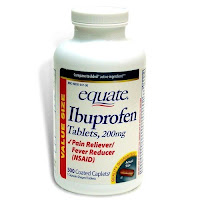Activity Intro:
In brief, the electrons that
surround elements interact in a good way with electrons around other elements
to create chemical bonds. These chemical bonds are what hold atoms
together to form molecules. Molecules are the most common form of chemical
substances that we experience everyday in our lives. If you go to Tylenol
on wikipedia there is a good example of information on the molecule and the
chemical structure of Tylenol. In the upper right of the page there is a
structure called a Ball and Stick model. This model represents atoms that are
held together by chemical bonds. In this model (which is quite common for
chemistry) the black balls represent carbon atoms, the white balls represent
hydrogen atoms, the blue balls represent nitrogen atoms, and the red balls
represent oxygen atoms. Notice that it is possible to have 1 or even 2
bonds between some of the atoms. The other image is called a Kekule
Diagram. This is the short-hand method that scientists use to draw
molecules. It is very common for scientists to not indicate the carbon
and hydrogen atoms since these are so common in molecules it becomes quite
tedious! So it becomes necessary to understand that the Kekule structures
are short-hand notation for the more accurate Ball and Stick model. The
other common information needed for molecules is the molecular formula (this is
the count of each type of atom in the molecule) and the formal chemical name.
While in wikipedia on Tylenol, if you click on acetominophen or
paracetamol you come to a page that has the detailed chemical information on
this common drug. On the upper right is the same images. Under the images
you will notice the systematic or IUPAC name. This is the name that
scientists call this molecule. Also on the right you will notice the
detailed chemical properties for this molecule, one of which is the formula, C8H9NO2.
So, in Tylenol there are 8 carbon atoms, 9 hydrogen atoms, 1 nitrogen atom and
2 oxygen atoms.Questions/Activities:
1. Post a picture of three 3-dimensional Ball and Stick molecular models(choose your three favorite molecules) that you have created with common items around your home. Also post a molecular structure image(image from the web, of either a Kekule Structure or a Ball and Stick Model) and the IUPAC name of the molecule.
- The two images below are of the molecule Carbon monoxide, also known as CO. Preferred IUPAC name is Carbon monoxide. Yellow is Oxygen, Red is Carbon on homemade model.
- The two images below are of the molecule Carbon dioxide, also known as CO2. Preferred IUPAC name is Carbon dioxide. Yellow is Oxygen, Red is Carbon on homemade model.
.png)
- The two images below are of the molecule Water also know as H2O. Preferred IUPAC name is Water Oxidane. Yellow is Oxygen, Blue is Hydrogen on homemade model.

2. Post an image from the web, the chemical systematic (IUPAC) name, common name, and the molecule formula for 20 chemicals that you use or eat. Explore the ingredients of things like cosmetics and foods.
1. Water oxidane, also known as water. H2O.

3. Sodium tetraborate decahydrate, also known as borax. Na2B4O7·10H2O
6. Ethanoic acid, also known as vinegar. C2H4O2
7. Sucrose, also known as table sugar. C12H22O11
8. 2-acetylsalicylic
acid, also known as Aspirin. C9H8O4
9. Ethylene glycol, also known as antifreeze. C2H6O2
10. Aluminum chlorohydrate, also known as antiperspirant. Al2Cl(OH)5
11. Carbon, also known as graphite. C
12. Propane, known as propane. C3H8
14. 1,3,7-trimethyl-1H-purine-2,6(3H,7H)-dione ; 3,7-dihydro-1,3,7-trimethyl-1H-purine-2,6-dione Also known as caffeine. C8H10N4O2
16. 2-hydroxypropane-1,2,3-tricarboxylic
acid. Also known as citric acid. C6H8O7
18. Ethanol, also known as Alcohol. C2H6O
19. Dihydrogen dioxide, also known as Hydrogen peroxide. 2(HO)
20. Sulphuric acid, also known as battery acid. H2SO4
- Carbon - 4 bonds
- Hydrogen - 1 bond
- Oxygen - 2 bonds
4. What does IUPAC stand for?
- International Union of Pure and Applied Chemistry
5. As you explore ingredients, notice how everything around us is made up of chemicals consisting of atoms bound together into molecules. But what about companies that claim their products are chemical free! How can this be? Here is an example:
http://www.naturalhealthcareproducts.com/Cleaning-Products.php
Do a little web searching and propose what chemicals are actually in this product. Keep in mind, that everything at the molecular level is a chemical, whether it be made in nature or in a lab.
- According to the website given, it sounds like all of the ingredients are made in nature and not from a lab. One website suggests "Its ingredients are derived from raw vegetable materials with corn supplying the carbohydrate/sugar base, which is then combined with native oils such as coconut, or palm kernel oil to produce a material called an alkyl polyglyoxide. When combined with other suitable biodegradable materials these polyglyoxides produce high quality cleaning compounds and shampoos. The polyglyoxides enhance product performance and promote exceptionally low cosmetic mildness." Because this product seems to be in a liquid or gel type of form, there is most likely some water in the product which automatically puts a chemical into the product. By chemical free, the company probably means non-toxic chemicals. There are also probably some plants in the formula also.
- http://www.angelfire.com/oz/rainbowsacs/Aussie_Green.html



.jpg)



















No comments:
Post a Comment